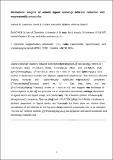Mechanistic insights of anionic ligand exchange and fullerene reduction with magnesium(I) compounds
Abstract
Ligand exchange reactions between combinations of the complexes [{(Arnacnac)Mg}2], where Ar = 2,6-iPr2C6H3 (Dip), 2,6-Et2C6H3 (Dep), 2,4,6-Me4C6H2 (Mes), and 2,6-Me2C6H3 (Xyl), [({Ph2P(NDip)2}Mg)2], [(Arnacnac)Li], where Ar = Mes or Xyl, and [{Ph2P(NDip)2}Li] were studied in deuterated aromatic and aliphatic solvents, and tetrahydrofuran. The reactions afforded product mixtures with asymmetrically substituted dimagnesium(I) complexes [(Arnacnac)MgMg(Ar'nacnac)], where Ar, Ar' = Dip, Dep, Mes, Xyl and [{Ph2P(NDip)2}MgMg(Arnacnac)], where Ar = Mes or Xyl, and suggest that the exchange of anionic ligands on the Mg22+ ion proceeds via an associative mechanism and is strongly dependent on ligand sterics and ligand shape, and can be very rapid. The activation reaction of fullerene C60 by dimagnesium(I) complexes [{(Arnacnac)Mg}2] and [({Ph2P(NDip)2}Mg)2] to fulleride complexes is similarly dependent on ligand sterics and ligand shape, but likely does not involve direct coordination of the fullerene to the Mg centre in dimagnesium(I) compounds prior to its reduction. The new C606- fulleride complex [({Ph2P(NDip)2}Mg)6C60] was prepared, and spectroscopically and structurally characterised.
Citation
Lawrence , S , Cordes , D B , Slawin , A M Z & Stasch , A 2019 , ' Mechanistic insights of anionic ligand exchange and fullerene reduction with magnesium(I) compounds ' , Dalton Transactions , vol. In press . https://doi.org/10.1039/C9DT03976G
Publication
Dalton Transactions
Status
Peer reviewed
ISSN
1477-9226Type
Journal article
Description
This work was supported by the University of St Andrews and the EPSRC (PhD studentship for SRL; EP/N509759/1).Collections
Items in the St Andrews Research Repository are protected by copyright, with all rights reserved, unless otherwise indicated.

